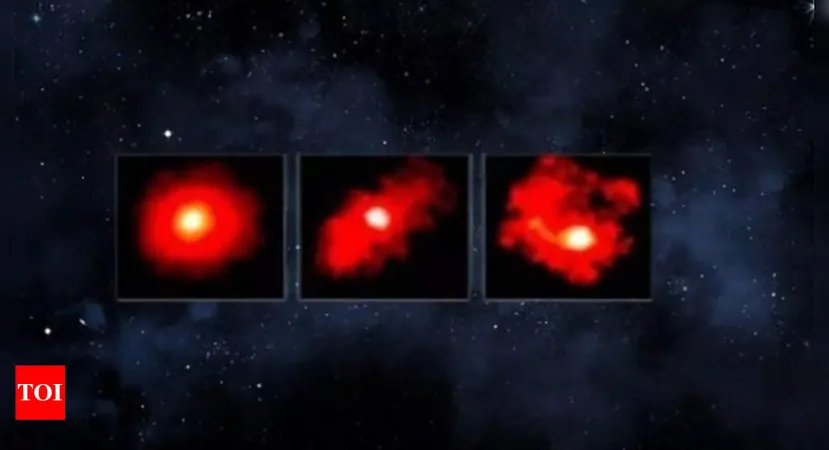
Jaw-Dropping Discovery: James Webb Telescope Uncovers Massive 'Red Monster' Galaxies Shattering Cosmic Norms
2024-11-18
Author: Jacob
In a groundbreaking revelation, the James Webb Space Telescope (JWST) has identified three colossal galaxies, referred to as "red monsters," that are radically altering our understanding of galaxy formation in the early universe. Formed just one billion years after the Big Bang, these behemoths boast masses roughly 100 billion times that of our Sun, significantly surpassing previous expectations for such an early cosmic period.
A Glimpse into the Cosmic Dawn
These ancient galaxies, dating back over 12.8 billion years, emerged during what is known as the "cosmic dawn," when the universe was still in its infancy. Traditionally, astronomers believed that galaxy formation was a slow and gradual process, governed by various physical constraints. However, these newly discovered red monsters are proving to be a formidable challenge to those established theories, suggesting that galaxies formed at a pace far quicker than previously believed.
The unique red glow of these galaxies, captured by JWST’s Near Infrared Camera (NIRCam), results from the stretching of their light due to the universe's expansion—a phenomenon known as redshift. This red hue is a telltale sign of their age and the conditions surrounding their star formation. During the early universe, abundant cosmic dust often obscured the light from forming stars, making JWST's infrared capabilities crucial for revealing these distant wonders.
Hurdles in Our Understanding of Star Formation
One of the striking characteristics of these red monsters is their extraordinary rate of star formation. Approximately 80% of their gas has been converted into stars, a staggering figure when compared to more typical galaxies today, which convert about 20% of their gas into stellar material. This rapid formation suggests that these ancient galaxies were exceptionally effective star-makers, operating under conditions not yet fully understood by modern astrophysics.
Stijn Wuyts, an astronomer at the University of Bath, remarked on the enigmatic nature of these discoveries, labeling them as a "tantalizing puzzle." This challenges conventional wisdom and implies that there could be unknown processes at work that foster more rapid star formation in the early universe.
Revolutionizing Galaxy Formation Theories
The implications of these findings are profound. They raise critical questions about how swiftly galaxies can grow in the early universe, hinting that the cosmic environment may have permitted a more efficient formation of stars than previously thought. Notably, factors that typically regulate star formation—such as gas availability and gravitational interactions—may have operated differently at the universe's dawn.
Mengyuan Xiao, the lead researcher behind this discovery, has indicated that this might prompt a significant reassessment of our galaxy evolution models. These revelations beg us to rethink how cosmic structures evolved only hundreds of millions of years after the genesis of time.
JWST's Pivotal Role in Cosmic Exploration
The JWST is at the forefront of modern astronomical research, providing unparalleled capabilities to inspect the cosmos in unprecedented detail. With its advanced infrared technology, the telescope is unlocking treasures from the universe's infancy—revealing phenomena previously hidden from our view. As expressed by Wuyts, "JWST is launching a new era of cosmic exploration," offering fresh insights into how galaxies might have evolved differently compared to their later counterparts.
As researchers continue to delve into the mysteries of these red monster galaxies, future studies promise to uncover even more knowledge about the dynamics of early cosmic development. Joint observations involving JWST and other instruments like the Atacama Large Millimeter/submillimeter Array (ALMA) will aim to dissect the structure and formation processes of these enigmatic entities.
The Future of Cosmic Understanding
This revolutionary discovery not only redefines our understanding of galactic evolution but also points toward an exciting potential for uncovering more secrets of the early universe. As the scientific community grapples with these newfound realities, the work of the James Webb Space Telescope stands as a beacon of innovation and exploration, paving the way for a deeper comprehension of the cosmos.
Prepare for a thrilling journey as we explore how these "red monster" galaxies can reshape the narrative of cosmic evolution—it's just the beginning of a stunning chapter in our understanding of the universe!









 Brasil (PT)
Brasil (PT)
 Canada (EN)
Canada (EN)
 Chile (ES)
Chile (ES)
 España (ES)
España (ES)
 France (FR)
France (FR)
 Hong Kong (EN)
Hong Kong (EN)
 Italia (IT)
Italia (IT)
 日本 (JA)
日本 (JA)
 Magyarország (HU)
Magyarország (HU)
 Norge (NO)
Norge (NO)
 Polska (PL)
Polska (PL)
 Schweiz (DE)
Schweiz (DE)
 Singapore (EN)
Singapore (EN)
 Sverige (SV)
Sverige (SV)
 Suomi (FI)
Suomi (FI)
 Türkiye (TR)
Türkiye (TR)